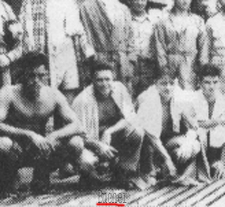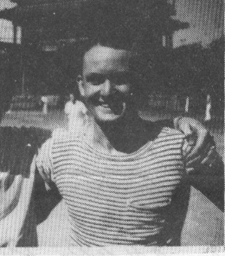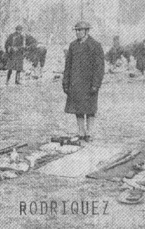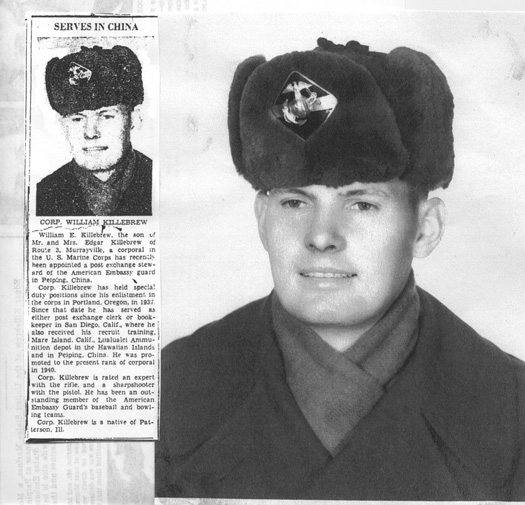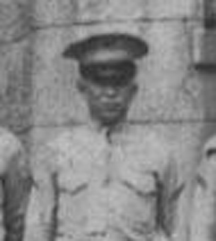|

Escapes
Two Marines from Peking, Donald Marshall and George Stone, escaped the original move to Woosung in January of 1942, but were recaptured. See Jerold Story Escapes above for more details.
Four North China Marines escaped from Woosung in March of 1942 and were recaptured in April. These men were Connie Battles, Charles Brimmer, Charles Stewart, and Jerold Story. Upon their recapture they were imprisoned in Ward Road Jail in Shanghai.
In October of 1944 Jerold Story escaped from Ward Road Jail successfully. Brimmer and Stewart were part of this escape attempt as a second group going over the wall at the same time. This group was immediately re-captured. In January of 1945 they were sent to Nanking, August of 1945 to Peking, 18 August of 1945 transferred to Fengtai civilian camp, and reached by US forces on 23 August 1945. Battles was too ill to participate in the Oct 1944 escape attempt. I am assuming the information on the recapture and Aug 23, 1945 rescue of Brimmer and Stewart based on information about Commander Cunningham from Wake, who was part of their escape attempt. It appears Battles was also at Nanking in August 1945. I have seen a letter written by Charles Brimmer to Francis Plog in which Brimmer states the details of his attempted escape from Ward Road in Oct 1944 were not as portrayed in the book Officially Dead as written about Commander C. D. Smith, Commander John Wooley, and Corporal Story. (This is undoubtedly because the book was written in 1945, before the war was over. Details were changed in the story in order not to put any one still under Japanese control at risk.) These 3 individuals successfully returned to US forces in Chungking. Brimmer received a life sentence in prison from the Japanese authorities for this second attempt. Stewart, Brewer, and Coleson each got eight years. Sources vary on the exact sentencing.
After recapture they were sent of Bridge House in Shanghai and then to Kiangwan Military Prison for their trial for "desertion." On 19 Jan 1945 they were sent to the military prison in Nanking. There they had no heat, blankets, or medicine, and very little food or water. Beatings were frequent. Four of the Doolittle fliers were also there. They were allowed one bath a week, using the same water 700 Japanese troops used first. Cunningham, Coulson, Brewer, Brimmer, Battles, Stewart, and Herndon were all in one cell. When the window was boarded over two of them passed out. Stewart and Brimmer broke open the window to allow air in. As a result they were put in leather jackets and chains were attached to their ankles. Water was poured on the jackets to stretch them and then the straps were tightened. They were then dragged around a field by the chains. Battles, Brewer, and Herndon were then given the same treatment. Next they were all placed face up in the sun and the jackets allowed to dry and shrink, all the while being kicked by the guards. Along with numerous fractures all of them were blind for three days. On 1 Aug 1945 they were transferred to Peking Military Prison and told the war was over on 15 Aug 1945. Stewart was back in New York on 5 Sep 1945 and it seems all of them were flown out together. (A series of newspaper articles can be seen after the info on Deaths below. They describe in detail what happened to Battles, Brimmer, and Stewart after the Oct 1944 escape attempt.)
(See Corporal Story and his two escapes above)(Connie Battles suffered for years from epileptic seizures caused by a blood clot on his brain which was a result of the beatings he received.) NCM Richard Huizenga and James McBrayer escaped from the train while the prisoners were being moved from Kiangwan to Fengtai and then Japan in May of 1945. With them were Wake Island Marines John McAlister and John Kinney and Flying Tiger pilot Lewis Bishop. They successfully reached US forces together. Wake Island civilians Bill Taylor and Jack Hernandez escaped from the train on a separate night. Hernandez broke his leg and was recaptured. Taylor reached Communist forces, then US forces. Douglas A. Bunn may have escaped from Ward Road Jail in May or June 1945 during a bombing raid. Was immediately recaptured (he had a broken leg) and eventually sent to Fengtai. Finally rescued there by US forces. (See details at report on Ward Road Jail on the page POW Camps holding North China Marines.)
Deaths
see pictures below(next of kin info is at time of death)
The following North China Marines died while prisoners of the Japanese:
Carrol Wilson Bucher – died from electrocution from a perimeter fence in Woosung 28 Aug 1942 (photo below)(Mr. and Mrs. Floyd Bucher, 4375 So Delaware St., Englewood Colorado)
Holland Cash – died from complications following an appendix operation in Kiangwan 18 Nov 1944 (photo below)(Guardian: Mr. Robert B. McCord, Ormewood Court, Atlanta Georgia.)
Ralph Harris Goudy – died from food poisoning in Tokyo No. 5 Dispatched Camp-Kawasaki 12 Mar 1944.. The POWs were always hungry and he found an open can with food remains in it. Cause of death listed as heart failure. (Photo below) ( Mr. Willard Goudy, 367 South Ave A, Canton, Illinois)
William E. Killebrew – died from pneumonia at Fukuoka #3-B 10 Feb 1944. (Photo below) Killebrew was married to Nadia Petrov on 7 May 1941 in Peking. His mother tried to help Nadia get to the states but could not contact her after the war began. The family never heard from her or of her from that time.(Mr. William E. Killebrew Sr, Rt 4, Murrayville Illinois) Although pneumonia was listed by the Japanese as cause of death the combination of hard physical labor and malnutrition were the real causes. Any illness such as pneumonia, which would have been easily treatable under ordinary circumstances, were exacerbated by the extreme conditions under which the POWs lived and the lack of medical care provided.
Raymond Elmo Lease – died at Ofuna 31 Dec 1944 according to NARA records, but actually died at Tokyo No. 5 Dispatched Camp-Kawasaki. Enterostenosis is listed as the cause of death. (Mrs. Bertha Hawthorne, Cheyenne Wells, Colorado)
Max H. Nuese – died at Fukuoka #3 after a beating with tongs, possibly in the factory, apparently catches pneumonia after beating, 13 Dec 1944. Cause of death listed as croup pneumonia and beri-beri. Scroll down past photos for affidavit concerning the death of Max Nuese, and his photo.(Mrs. Rosa Nuese, 410 S Union St, Braunfels Texas)
Richard Rider – killed in an air raid at Osaka 13-B Tsumori on the night of 13 March of 1945. Cause of death listed as injury of the lung. He was hit in the chest by shrapnel. ( Mr. Henry Rider, 521 D St, Lincoln, Nebraska)
Clyde Edward Roark – died 29 Jan 1945 at Kiangwan according to NARA records. (Photo below)(Mr. and Mrs. Edward H. Roark, Paoli Oklahoma)
Fernando C. Rodriquez – died at Osaka 13-B Tsumori on 5 Nov 1944. Cause of death listed as pulmonary tuberculosis. (Photo below) (Mr. and Mrs. Agapito Rodriquez, 4316 Allen St, Houston Texas) He is buried at the Manila American Cemetery, Plot B, Row 12, Grave 166. We can assume it is his ashes that are buried there. The Japanese cremated most, if not all POWs that died in camps in Japan, and stored the ashes in marked containers.Photo and information on Fernando Rodriquez's grave came from retired USMC Sgt Maj Bert Caloud who works at the Manila American Cemetery.
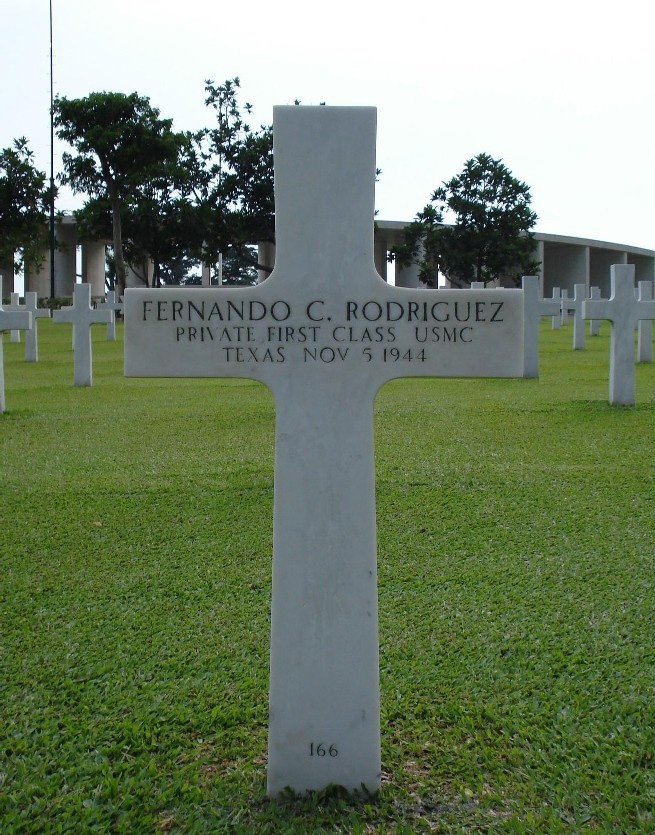
Most of the photos below were taken from pre-war issues of the Peking Marine and the Tientsin Marine.
Underlined in red in above photo at left is Carroll Bucher. Marked in red in photo at right is Holland Cash.
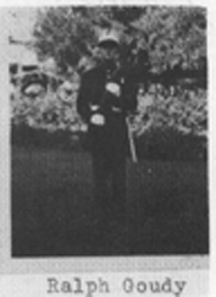
Ralph Goudy is above and to the right.
Above is Fernando C. Rodriquez.
William Killebrew is above. Photo and news clip sent to me by his niece Jo Waltrip.Further info on William Killebrew and his wife can be found on the page
POW Letters and Documents (part two) and on the page Diamonds on their Hats.
Clyde Roark arrived in Tientsin in Aug 1940.
The following affidavit was submitted by North China Marine Alvin Ernest Sawyer on 22 October 1945 in Oakland, California. Originally classified Confidential, the document was declassified on 28 February 1950.
Alvin Ernest Sawyer, being duly sworn, deposes and says: My permanent home address is 507 Bowman Avenue, East Alton, Illinois. I am a Corporal in the U.S. Marine Corps and my serial number is 272867. I am 29 years of age and have had two years of high school training. I was taken prisoner by the Japanese on 8 December 1941 at Tientsin, China. I was a prisoner of war of the Japanese at Camp Tobata #3, Japan from 5 November 1942 until 12 September 1945. At this camp prisoners were compelled to work in the factory of the Yawata Steel Company under the supervision of civilian foremen, whom we called "pushers". One of these civilian pushers was a Japanese named YAMASTA. He was a man about 43 years of age, 5'4" tall, 160 pounds, and has a large scar across his left cheek bone extending from under the left eye almost to the mouth. In October 1944 I saw this man severely beat Private First Class Max NEUSE, U.S.M.C. He used a steel bar about 1" in diameter and 5' long and struck NEUSE across the small of the back and the shoulders until NEUSE was rendered unconscious. After NEUSE became unconscious, YAMASTA would not permit other prisoners to go to his aid. NEUSE regained consciousness and was compelled to work for about 45 minutes when he fainted. At this time the Japanese interpreter, named NISHI, took NEUSE to the factory hospital where he was treated and then sent to the prison camp. NEUSE died about one month afterward. During part of this month he was treated by a Dr. MARKOWITZ, an American Naval Officer whose rank I cannot recall. Dr. MARKOWITZ later told me that he was of the opinion that NEUSE died from internal injuries received as a result of the beating which I have described. The above beating occurred in the Yawata Steel Company factory, when NEUSE failed to salute YAMASTA. YAMASTA had screamed the Japanese word for salute at NEUSE, and NEUSE replied in Japanese that he did not understand.22 October 1945 signed Alvin E. Sawyer Subscribed and sworn to before me this 22 day of October 1945 at Oakland, California, U.S.A. signed Jack P. Kaetzel LtCommander, USN
Max Nuese shown below.
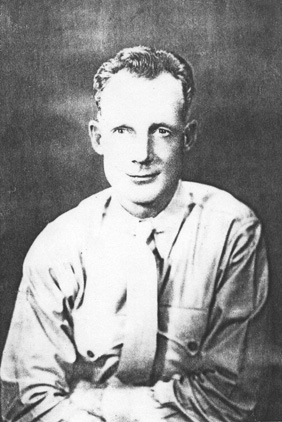
|

Newspaper article below provides details of what happened to those who were recaptured after the escape attempt in October 1944. Provided by Steve and Diane Stewart. Steve is the son of Charles A. Stewart, Jr.
October 1945 St. Louis Post Dispatch
St. Louisan whom Japs recapture twice is back home after 5 years
Cpl. Charles Stewart Jr. again meets Marine companion on two escapes – held since Pearl Harbor Day
Marine Cpl. Charles A. Stewart Jr., a prisoner of the Japanese from the outbreak of the war until freed by an American parachute team in China last month, was home in St. Louis today after more than five years.
His long imprisonment, marked by two escapes, an interlude as a fugitive living with Chinese guerillas and periods of Japanese torture, ended August 18, when a United States rescue team jumped into Pekin in North China, he related. He was released with (unclear… looks like “nine”) other Americans held there including four Doolittle flyers. Stewart, 23 years old, returned Thursday, and is spending furlough with his parents, who live at 3501 Itaska street.
“Freed by Grace of Japanese”
When Stewart and the other Americans were let out of their cells in the Pekin military prison, he said, the Japanese major in command told them they were being released “by grace and goodness of the Japanese people”. That was after the parachute team had assumed authority and ordered the liberation.
“The Jap officer” Stewart said, “wanted us to bow and salute him and the Japanese Emperor. We told him nothing doing.”
Stewart told his story at a press conference at Marine Corps recruiting headquarters in the new Federal Building yesterday.
His imprisonment began the days after Pearl Harbor in Pekin, where he was assigned to the American embassy guard. With the start of the war, The Japanese garrison rounded up all Americans. Previously, Stewart had served at the Marine barracks at Tientsin for about 8 months.
Early in 1942, when in a prisoner of war camp outside of Shanghai, Stewart and three comrades made an break.
With Guerrillas 17 days
“We found out when the dynamo wasn’t running and there was no electricity in the wire enclosure,” he recounted. “We hid under some stables near the fence, then we crawled out. We walked all day in the open country. Chinese farmers were friendly. We circles Shanghai, and hiked 50 miles southward.
“By this time, Chinese guerrillas were on the lookout for us, the same as Japs. Their intelligence system was working. Their Scouts picked us up. They were wonderful to us.“
After 17 days, he and the others were recaptured when a Japanese expedition surrounded the guerrilla detachment they were with. Stewart then was “court-martialed, “ he said, and sentenced for four years for “desertion from the Japanese army.”
He was removed to the Japanese interrogation center Bridge House, Shanghai,” he said, “where he spent 73 days of torture. Food was a bowl of rice three times a day. Guards beat and kicked him and ---pings were a regular thing in hours of questioning. Some days even the rice was withheld. He lost 60 pounds.
He was transferred to the Road House jail in Shanghai, and participated in another escape in October, last year. He was captured after a few hours. He was sentenced to an additional 10 --- for “desertion,” he said and a second stay at Bridge Road. He was moved to a Nanking prison, where he remained until August 1 going from there back to Peking.
Met by fellow ex-captives
With him on the first escape and successful on the second was Marine Platoon Sgt. Jerold B. Story of Bloomington, Ill. Story came to St. Louis from Quantico, Va., yesterday to see Stewart. Story who made the successful escape, made his way to Chekiang Province and reached an American base, he said. Later he repatriated.
Stewart was flown back to the United States after the liberation at Peking. He arrived in New York Sept. 5, he said, and was sent to the naval hospital in Norman, Okla., for treatment. He is on a 90-day leave. He says next he is “expected to go to Washington D. C. to clean up my affairs.”
After joining the Marines in Jan-- 1940, he attended Hadley Technical School.
October 1945 St. Louis Post Dispatch
Japanese victims meet at Marine Corps recruiting office in the Federal Building for the first time since October, 1944, when one of them, Marine Platoon Sgt. Jerold B. Story (left), Bloomington, Ill., escaped from the prison camp in Shaghai, where they both were held. Marine Cpl. Charles A. Stewart Jr., 3501 Itaska st., was liberated by American forces last month. The two Marines were taken prisoner at the outbreak of the war at Pekin, China, where they were on guard duty at the American Embassy.
October 1945 (St. Louis) Two Men Reunited Here, Recall Prison Camp Experiences
A tale of capture and torture by the Japanese in the early days of the war when both me were on guard duty at the American Embassy in Peiping, China, and subsequent escapes and recapture, was told here yesterday by two marines who met for the first time since one of them escaped in October, 1944, from the Japanese prisoner camp where both were held.
As Cpl. Charles A. Stewart Jr. 3501 Itaska st., saw his companion in misery, Platoon Sgt. Jerold B. Story, Bloomington, Ill., for the first time in almost a year yesterday at Marine Corps recruiting Headquarters in the Federal Building, he fell on him with shouts of glee and the surprised remark, “So, you’re still alive!”
There followed a recounting of experiences in which both had shared and each had endured since Story escaped from their prison camp in Shanghai, China, in October 1944.
Taken to the Shanghai camp on February 1, 1941, shortly after their capture in Peiping, both men escaped March 31, 1942, and managed to join Chinese guerrilla forces. However, 17 days later they were recaptured in the Shanghai hills.
Following this, as Stewart tells it, “We were taken to a Japanese Gestapo headquarters in Shanghai where for 78 days we were tortured and then were transferred to a prison camp in another part of Shanghai.”
Both men escaped October 6, 1944, but Stewart was recaptured in a few hours. Story, however, managed to reach Chinese guerrilla forces and eventually made his way to American forces in Chekiang Province, China.
On August 1, 1945, Stewart was transferred to a military prison at Peiping, China, where he was liberated by an American parachute team August 18.
1945-10 (St. Louis) Marine Home; Fled Jap Jail Twice
Captured on the second day of the war with Japan , Marine Cpl. Charles A. Stewart Jr., 23, of 3501 Itaska st., twice was given a jail sentence for escaping from Jap prison camps.
The charge was desertion from the Jap army!
Stewart is home now, on a 90-day leave. He seems trim and fit, although there is a tight look about his eyes and his nerves aren’t too quiet.
But it was only a little more than a month ago that he was freed from a Jap prison at Peiping, China. He was flown to New York September 5, spent a little time in a government hospital and arrived home Thursday.
Visiting is his close friend, Marine Platoon Sgt. Jerold B. Story, 29, of Bloomington, Ill.
Both men, American Embassy guards in Peiping when war struck, were captured together. Twice they escaped together. The first time they were free for 17 days, living with Chinese guerrilla forces near Shanghai.
The second time Stewart was recaptured within a few hours but Story made his way with guerrilla aid to American forces in Chekiang province, China, and was flown home.
“For the first escape we were tortured, tried and finally sentenced to four years in prison for desertion from a Jap army, “ Stewart said yesterday. “Later I got 10 more years, for the second offense.”
“We crawled under an electrified fence one noon on March 31, 1942. Learned a little Chinese and the people guided us.
“We kept asking about guerrillas but naturally no one was anxious to reveal their location. Finally, though, we learned the guerrillas had heard of us and had sent scouts to pick us up. No one in the world could have been more wonderful to us than those guerrillas.”
The men knew at least four of the Doolittle flyers who were stationed at the same camps with them, including Capt. Jay Nielsen, whose experiences now are being published in the Star Times.
“We couldn’t talk with them,” said Sgt. Story. “We were beaten and given water treatment and the marines said, their treatment became more brutal than ever.
“Then at 8 p.m. on August 14, a Jap officer opened our cell doors and ordered us oustside. A Jap major told us that ‘by the grace and goodness of the Jap people you are to be released.’ Then he asked us to salute him and bow to the emperor. We didn’t. We just stood silent. Our reaction to the news was one of extreme numbness. We couldn’t realize it.
“Four days later a parachute team of about eight Americans floated from the sky. They were fired on but didn’t fire back. They just took command, setting up quarters in a hotel. We were released, but the Tokyo flyers weren’t . The Japs said -- ----- ----- -- .“ (words cut off)
1945-10-25 Greenville, Ill. Cpl. Chas. A. Stewart, Jap Prisoner Nearly Four Years, Tells of Tortures
Surviving nearly four years of everything the Japanese could dish out in the way of torture, and becoming one of eight prisoners to escape from Ward Road Jail, the largest prison camp in the world, supposedly escape proof and where 10,000 prisoners were incarcerated, Corporal Charles A. Stewart Jr., of St. Louis, a grandson of Robert Breuer and a great nephew of Mrs. Anna Birnstiehl of this city, recounted some of his experiences to a reporter for the Advocate Wednesday morning. Corporal Stewart, with his father and a friend, Hal P. Mills, former publisher of ---- Shanghai, China, newspapers, spent a few days here the first of the week relaxing, fishing and loafing and visiting, Young Stewart is quite well-known here as he formerly spent his summer vacations with relatives.
Corporal Stewart, now 24 years old, enlisted in the Marines January 15, 1940, at St. Louis and after his basic training was sent to China with Marine replacements in May of that year and was stationed in Tientsin, China. Later he was transferred to Peiping as an embassy guard and was captured there following Pearl harbor. He was then sent to the Woosung prison camp and in the company of three other Marines escaped from this camp March 31, 1942. Their liberty was short; as they were recaptured April 17, about 50 miles south of Shanghai and placed in the Bridge House, known as “the house of torture.”
Held here 76 days he was subjected to beatings, the water cure, kept on a starvation diet of fish heads, rice and a little seaweed now and then, they were later taken to the Kingwang Military Court and there tried for “desertion from the Japanese army,” a trumped up charge, of course, found guilty and sentenced to four years imprisonment.
On July 9, 1942, he with others was transferred to the Ward Road jail, the largest jail in the world, where there were 10,000 prisoners. While this jail was supposed to be escape proof, with no prisoner ever having gotten out, Stewart, with seven others made this escape from this jail October 6, 1944. Three men were successful but the five others, including Stewart were caught at Shanghai, after he had, to put it in his own words “clouted” two Japanese soldiers, who stopped them, in itself a dangerous undertaking.
Asked how they made their escape from the Ward Road jail, he said they had outside help from some Danish boys (Borg Theodore Petersen and Mr. Olafsen), who had been discharged from the prison. They provided them with hacksaw blades and the Yanks were able to saw their way out.
Back to Bridge House they were taken and there subjected to most all tortures in the Jap book, where they were questioned in an effort to make them divulge military information. They were sent back to Kingwang and again tried for “deserting the Japanese army”. This time their sentence was 14 years in prison, although their original sentence had been death.
They were then taken to Nanking to the Japanese military prison on January 19, 1945. This as described by Stewart was a super hell-hole. No heat, no blankets, no beds, no medicine, not enough drinking water to quench their thirst, and very little food. Stewart said his feet nose and ears were frozen as well as being starved and he lost 70 pounds. The treatment by the guards was even more severe here than in other prisons, and they were subjected to severe beatings, administered at the whims of the guards. They were allowed to bathe once a week, in a large tank, after 700 Japs had used the same water. The prison was alive with vermin. When the guards were told that the prisoners were ill, they just laughed. The guards gave orders in Japanese and if you could not understand it was just too bad. However, Stewart and his buddies were able to speak and understand the Japanese language, which he said took him about a year and a half to master. While in this Nanking prison, the only other Americans outside his own group were four of the Doolittle flyers and J.B. Powell, the New York newspaper man who lost both his legs by having them frozen while in a Jap prison. Powell however was repatriated and came to the states about a year ago.
There were seven men in their cell on January 25, 1945, the cell being 9x14 feet. Due to breaking the rules to talking to one another in the cell, the Japanese officials ordered all windows closed, shutting off what little ventilation they had. In this group were Commander W. S. Cunningham, U.S. Navy captain; Sgt. R. L. Coulson of the Marines, C. T. Brewer, pharmacists mate second class, Cpl. Chas. W. Brimmer and Cpl. C. G. Battles of the Marines and Pat Herndon, a civilian contractor and Stewart. The guard, when requested to open the windows, only laughed because commander Cunningham was on the floor, recovering from an illness and diarrhea and Sgt. Coulson, also on the floor, recovering from typhus, both extremely weak from their illness and suffering from the extreme heat, had fainted. The remainder were also suffering from the intense heat and they decided to break out the windows, which they did.
A general alarm was given and Stewart and Brimmer were accused of breaking the windows. For this they were taken out into the brilliant sunshine, put in leather straight jackets and chains placed around their legs. The jackets were tightened to the last notch and then water poured over the jackets to make them stretch and cinched tighter, another hole being made in the straps. The pain in their chests were terrific. They were then dragged around the field by the chains on their legs, causing them to be badly bruised and disheartened. (word is unclear)
They were then laid in the sun, face up and the heat from the sun caused the jackets to shrink as the water dried out. More water was then applied. Battles, Brewer and Herndon were then brought out and they were subjected to the same torture treatment and laid in the sun, face up for over an hour. The pain was almost unbearable and the treatment they had used on the men caused the men to become sick and vomit, but they were made to remain on their backs all the while, and were abused by the guards, who kicked them, spit on them and cursed them.
When at last they were released from these jackets to their horror they were all blind and remained this way for three days, when their sight returned. Their muscles were extremely sore and Stewart had suffered a fracture from being kicked by one of the guards.
On August 1, they were transferred to the Peiping military prison. Everything they had gone through before was pink tea compared to what they were subjected to in this prison. On August 15, 1945 they were called out of their cells by the officer of the day and taken to the major, commanding the prison and he read them a proclamation: “You are now being released by the kindness and courtesy of the Japanese people. The war is over. We are so sorry for your treatment but due to the outstanding differences of our two countries we could not give you the treatment accorded to war prisoners of the Americans.” The officer had not advised them that japan had surrendered. He then asked them to salute him and as he bowed low the prisoners thumbed their noses.
They were then taken to the American refugee camp near Peiping where they contacted the American paratroopers. They were then flown from Peiping on August 22 to Sean, China, and then to Kunming, China, and hospitalized. Those in the group who were able to fly, were put aboard a plane, and flown to India, thence to Africa, and then to New York, where on September 5, Stewart was able for the first time in nearly six years to hear his mother’s voice, when he called her on the telephone.
Cpl. Stewart wears the good conduct medal, Asiatic-Pacific ribbon with two battle stars, and China-Burma-India theatre ribbon. He is now on a 90-day convalescent leave, but he has a total of 130 points and expects to be discharged in about 60 days. At the termination of his military service he expects to engage in business with his father in St. Louis.
Hal P. Mills became acquainted with Stewart in one of the prisons, when Mills was being held as a spy. He too, was subjected to much of the torture, and he and Stewart became friends, which friendship had been renewed. Mills, who is located in Kansas City, Mo., said he intends to return to China and resume the newspaper business just as soon as his passports come through. He is a member of the General Ward Post No. 1, American Legion post in that country. He has written several articles for the national Legion magazine. He was an United Press correspondent in Shanghai for many years.
|
![]()


